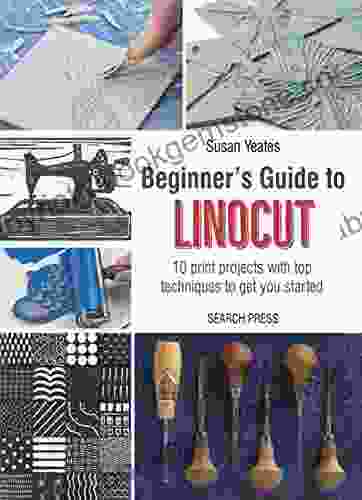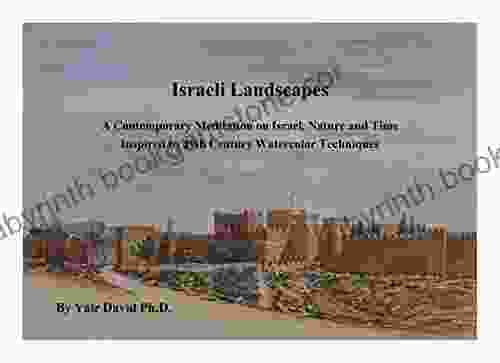10 Print Projects with Top Techniques to Get You Started

Printmaking is a versatile and rewarding art form that can be used to create a wide variety of images, from simple line drawings to complex multi-layered compositions. With a little practice, anyone can learn the basic techniques of printmaking and begin creating their own unique works of art.
In this article, we will introduce you to 10 print projects that are perfect for beginners. These projects will teach you the basics of printmaking and give you the opportunity to experiment with different techniques.
4.7 out of 5
| Language | : | English |
| File size | : | 135300 KB |
| Print length | : | 96 pages |
1. Relief Printing: Lino Block Print
Relief printing is a type of printmaking in which the image is raised above the surface of the printing plate. This is achieved by carving away the areas of the plate that will not be printed. Lino block printing is a popular form of relief printing that uses a linoleum block as the printing plate.
To create a lino block print, start by drawing your design on the linoleum block. Then, use a sharp knife to carve away the areas of the block that will not be printed. Be sure to carve carefully and evenly, as the depth of the carving will determine the amount of ink that is transferred to the paper.
Once the block is carved, ink it up with a roller and press it onto a piece of paper. The inked areas of the block will transfer to the paper, creating your print.
2. Intaglio Printing: Drypoint
Intaglio printing is a type of printmaking in which the image is recessed below the surface of the printing plate. This is achieved by scratching or engraving the design into the plate. Drypoint is a form of intaglio printing that uses a sharp needle to scratch the design into a metal plate.
To create a drypoint print, start by drawing your design on the metal plate. Then, use a sharp needle to scratch the design into the plate. Be sure to scratch carefully and evenly, as the depth of the scratches will determine the amount of ink that is transferred to the paper.
Once the design is scratched into the plate, ink it up with a roller and wipe away the excess ink. The inked areas of the plate will transfer to the paper, creating your print.
3. Planographic Printing: Lithography
Planographic printing is a type of printmaking in which the image is created on a flat surface. This is achieved by using a chemical process to create a water-resistant image on the printing plate. Lithography is a form of planographic printing that uses a limestone plate as the printing plate.
To create a lithograph, start by drawing your design on the limestone plate. Then, use a chemical solution to create a water-resistant image on the plate. The areas of the plate that are not water-resistant will absorb water, while the areas that are water-resistant will repel water.
Once the image is created on the plate, ink it up with a roller. The water-resistant areas of the plate will accept the ink, while the water-absorbent areas will repel the ink. The inked areas of the plate will transfer to the paper, creating your print.
4. Stencil Printing: Screen Printing
Stencil printing is a type of printmaking in which the image is created by using a stencil to block the flow of ink. Screen printing is a popular form of stencil printing that uses a mesh screen as the stencil.
To create a screen print, start by creating your design on a transparency. Then, transfer the design to a mesh screen. The areas of the screen that are covered by the design will block the flow of ink, while the areas that are not covered by the design will allow the ink to pass through.
Once the design is transferred to the screen, ink it up with a roller and press it onto a piece of paper. The ink will pass through the areas of the screen that are not covered by the design, creating your print.
5. Monotype Printing: Monoprint
Monotype printing is a type of printmaking in which the image is created by painting or drawing on a metal or glass plate. The plate is then inked up and pressed onto a piece of paper. Monoprints are unique, as each print is slightly different due to the nature of the printing process.
To create a monoprint, start by painting or drawing your design on the metal or glass plate. Then, ink up the plate with a roller and press it onto a piece of paper. The inked areas of the plate will transfer to the paper, creating your print.
6. Collagraph Printing: Collagraph
Collagraph printing is a type of printmaking in which the image is created by gluing different materials to a printing plate. The plate is then inked up and pressed onto a piece of paper. Collagraphs can be used to create a wide variety of textures and effects.
To create a collagraph, start by gluing different materials to a printing plate. The materials can be anything from paper and fabric to wood and metal. Once the materials are glued to the plate, ink it up with a roller and press it onto a piece of paper. The inked areas of the plate will transfer to the paper, creating your print.
7. Photogravure Printing: Photogravure
Photogravure printing is a type of printmaking in which the image is created by using a photographic negative to transfer the design to a metal plate. The plate is then etched with acid to create a recessed image. Photogravures are known for their rich tones and fine details.
To create a photogravure, start by creating a photographic negative of your design. Then, transfer the negative to a metal plate. The plate is then etched with acid to create a recessed image. Once the plate is etched, ink it up with a roller and press it onto a piece of paper. The inked areas of the plate will transfer to the paper, creating your print.
8. Digital Printing: Giclée Print
Digital printing is a type of printmaking in which the image is created using a computer and a digital printer. Giclée prints are known for their high quality and archival properties.
To create a giclée print, start by creating a digital image of your design. Then, print the image on a high-quality digital printer. Giclée prints can be printed on a variety of papers and canvases.
9. Experimental Printmaking: Cyanotype
Experimental printmaking is a type of printmaking in which the artist uses unconventional materials and techniques to create their work. Cyanotypes are a form of experimental printmaking that uses a chemical process to create a blue-tinted image.
To create a cyanotype, start by coating a piece of paper with a light-sensitive solution. Then, place a negative or object on the paper and expose it to sunlight. The areas of the paper that are exposed to sunlight will turn blue, while the areas that are not exposed to sunlight will remain white.
10. Mixed Media Printmaking: Mixed Media Print
Mixed media printmaking is a type of printmaking in which the artist uses a combination of different printmaking techniques to create their work. Mixed media prints can be very creative and unique.
To create a mixed media print, start by choosing two or more printmaking techniques that you would like to use. Then, experiment with different ways to combine the techniques to create your own unique work of art.
Printmaking is a versatile and rewarding art form that can be used to create a wide variety of images. With a little practice, anyone can learn the basic techniques of printmaking and begin creating their own unique works of art.
The 10 print projects in this article are a great way to get started with printmaking. These projects will teach you the basics of printmaking and give you the opportunity to experiment with different techniques. Once you have mastered the basics, you can start experimenting with your own ideas and creating your own unique works of art.
4.7 out of 5
| Language | : | English |
| File size | : | 135300 KB |
| Print length | : | 96 pages |
Do you want to contribute by writing guest posts on this blog?
Please contact us and send us a resume of previous articles that you have written.
 Best Book
Best Book Page Flip
Page Flip Bookshelf
Bookshelf Literary loom
Literary loom Chapter
Chapter Bookish
Bookish PageTurner
PageTurner Bibliophile
Bibliophile Story
Story Inkwell
Inkwell Bookworm
Bookworm Labyrinth
Labyrinth Plot Twist
Plot Twist Prose
Prose Paperback
Paperback Storyteller
Storyteller Sanctuary
Sanctuary Fiction
Fiction Reading
Reading Chronicle
Chronicle Read
Read Siri Hustvedt
Siri Hustvedt James Seabright
James Seabright Margaret Fletcher
Margaret Fletcher Hannah Hart
Hannah Hart Ian Frazier
Ian Frazier Olan Thorensen
Olan Thorensen Peter Ninnes
Peter Ninnes Yunte Huang
Yunte Huang Sasha Duerr
Sasha Duerr Taylor Fuller
Taylor Fuller Danielle Krysa
Danielle Krysa Tony Rafael
Tony Rafael Lisanne Norman
Lisanne Norman Harry Lorayne
Harry Lorayne Susan Cross
Susan Cross Ward Larsen
Ward Larsen Cora Tesheira
Cora Tesheira Eddie Robson
Eddie Robson Cristy C Road
Cristy C Road Sue Tabashnik
Sue Tabashnik Insun Lee
Insun Lee Porochista Khakpour
Porochista Khakpour Donald Spoto
Donald Spoto Robert Silverberg
Robert Silverberg Jeff Tanyard
Jeff Tanyard Cornelius C Kubler
Cornelius C Kubler Jodi Picoult
Jodi Picoult Daniel Ankele
Daniel Ankele Yair Lapid
Yair Lapid Harold P Howard
Harold P Howard Leslie Cabarga
Leslie Cabarga Thrive Language Audiobooks
Thrive Language Audiobooks Myriam Gurba
Myriam Gurba Dan Simmons
Dan Simmons Coryn Anaya Clarke
Coryn Anaya Clarke Dan Sugralinov
Dan Sugralinov Henry Koster
Henry Koster Criss Angel
Criss Angel Pat Grillo
Pat Grillo Keith Recker
Keith Recker Irving Layton
Irving Layton Sara Ackerman
Sara Ackerman Garry Mcgee
Garry Mcgee Janet Catherine Berlo
Janet Catherine Berlo Dallas Shaw
Dallas Shaw R Allen Chappell
R Allen Chappell D Ward Cornell
D Ward Cornell Helen Augur
Helen Augur Lan Sluder
Lan Sluder Jennifer Brozek
Jennifer Brozek Trenae
Trenae Michelle L Hardy
Michelle L Hardy Issa Rae
Issa Rae Dick J Reavis
Dick J Reavis Douglas Preston
Douglas Preston Cory Doctorow
Cory Doctorow Craig Johnson
Craig Johnson Rebecca Hardiman
Rebecca Hardiman Colin Souness
Colin Souness Daigo Murasaki
Daigo Murasaki Megan Lynch
Megan Lynch Olivia Campbell
Olivia Campbell Crypto Dukedom
Crypto Dukedom Torre Deroche
Torre Deroche Kyle Widner
Kyle Widner Gerald Everett Jones
Gerald Everett Jones Eric Jerome Dickey
Eric Jerome Dickey Dan Fox
Dan Fox William Powers
William Powers Pearl Tate
Pearl Tate Joan D Vinge
Joan D Vinge Steve Reifenberg
Steve Reifenberg Marko Kloos
Marko Kloos Jerry Brotton
Jerry Brotton Tom Satterly
Tom Satterly Connie Willis
Connie Willis Ron Celano
Ron Celano Monika Forsberg
Monika Forsberg D Dauphinee
D Dauphinee Linda Riesenberg Fisler
Linda Riesenberg Fisler Alexa West
Alexa West Eric Trueheart
Eric Trueheart Clive Johnson
Clive Johnson Eat Like A Local
Eat Like A Local Todd Geers
Todd Geers William Evans
William Evans Dale Robinson
Dale Robinson Sarah Culberson
Sarah Culberson Richard K Morgan
Richard K Morgan Dan Abnett
Dan Abnett Dave Willmarth
Dave Willmarth Kristen Britain
Kristen Britain D J Holmes
D J Holmes M R Forbes
M R Forbes Clayton Thomas Muller
Clayton Thomas Muller Ann Fessler
Ann Fessler John Grisham
John Grisham John Paul Brammer
John Paul Brammer Maham Johnson
Maham Johnson Leila Guerriero
Leila Guerriero Gerda Weissmann Klein
Gerda Weissmann Klein T J Clark
T J Clark Lorne Ryburn
Lorne Ryburn Mark Cramer
Mark Cramer Theo Dorgan
Theo Dorgan Lisa Morton
Lisa Morton W B Yeats
W B Yeats Bob Martin
Bob Martin Henry James
Henry James Scott Moon
Scott Moon Yutaka Yazawa
Yutaka Yazawa David Mikics
David Mikics Robert Appleton
Robert Appleton Coert Voorhees
Coert Voorhees Colson Whitehead
Colson Whitehead Kelly Gay
Kelly Gay Karen Cheung
Karen Cheung Diana Hollingsworth Gessler
Diana Hollingsworth Gessler Hannah Strong
Hannah Strong Brandon Q Morris
Brandon Q Morris Pierre Alex Jeanty
Pierre Alex Jeanty Kristina Evans
Kristina Evans Roy Kinnard
Roy Kinnard Colin Thubron
Colin Thubron Jason Cochran
Jason Cochran Massimiliano Musina
Massimiliano Musina Luis Alberto Urrea
Luis Alberto Urrea J Z Foster
J Z Foster Jim Hutchinson
Jim Hutchinson D J Bodden
D J Bodden Synithia Williams
Synithia Williams David Walton
David Walton Gianrico Carofiglio
Gianrico Carofiglio Peter Hanson
Peter Hanson Marisol Enchufa
Marisol Enchufa Margaret Coker
Margaret Coker Marius Kociejowski
Marius Kociejowski J Robert Kennedy
J Robert Kennedy Mary Boone
Mary Boone Fred Ladd
Fred Ladd Craig Melvin
Craig Melvin Ted Andrews
Ted Andrews Yuri Ulengov
Yuri Ulengov Henning Nelms
Henning Nelms Beverly Jenkins
Beverly Jenkins Les Standiford
Les Standiford Jessica Kerwin Jenkins
Jessica Kerwin Jenkins Colleen Hall
Colleen Hall Blair Polly
Blair Polly Frank Bruni
Frank Bruni Jon May
Jon May Dakota James
Dakota James Ella Barrick
Ella Barrick Gabrielle Selz
Gabrielle Selz Cristina Salat
Cristina Salat Cody Whitfill
Cody Whitfill Janet Koplos
Janet Koplos Clive Cussler
Clive Cussler Steven Skaggs
Steven Skaggs Curatoria Draconis
Curatoria Draconis Scott Kenemore
Scott Kenemore Gene Wolfe
Gene Wolfe Cookie Mueller
Cookie Mueller Pat Kramer
Pat Kramer Cornelius N Grove
Cornelius N Grove Jane Hamilton
Jane Hamilton Cynthia Leal Massey
Cynthia Leal Massey Stephen Brooks
Stephen Brooks Cynthia Saltzman
Cynthia Saltzman Elizabeth Reid
Elizabeth Reid Nathan D Horowitz
Nathan D Horowitz Damion Hunter
Damion Hunter Ursula K Le Guin
Ursula K Le Guin Niall Teasdale
Niall Teasdale Amaya Black
Amaya Black Jerry Beck
Jerry Beck Isadora Duncan
Isadora Duncan T R Napper
T R Napper Maya Angelou
Maya Angelou Jeremy Ford
Jeremy Ford D Scott Bowers
D Scott Bowers C F Jernigan
C F Jernigan Julie Lythcott Haims
Julie Lythcott Haims Cliff Mass
Cliff Mass Tony Pike
Tony Pike Sean Egan
Sean Egan Nigel Barley
Nigel Barley Nick Lyons
Nick Lyons Nicolas Lampert
Nicolas Lampert David Drake
David Drake Wade Motawi
Wade Motawi Mancho Soto
Mancho Soto Irene Levin Berman
Irene Levin Berman Cynthia Clampitt
Cynthia Clampitt Donna Zakowska
Donna Zakowska Kenya Clark
Kenya Clark Jessica Walstad
Jessica Walstad Marc Taro Holmes
Marc Taro Holmes Laura Donnelly Bethmann
Laura Donnelly Bethmann Eric Musgrave
Eric Musgrave Karen Swan
Karen Swan Julia Chiles
Julia Chiles Daniel Burleigh Parkhurst
Daniel Burleigh Parkhurst Isabella Maldonado
Isabella Maldonado Loretta Outwater Cox
Loretta Outwater Cox Susan Yeates
Susan Yeates Ellie Taylor
Ellie Taylor David Cousens
David Cousens Mike Katz
Mike Katz P A Piatt
P A Piatt Tim Vernooij
Tim Vernooij T Scott Bryan
T Scott Bryan John Parascandola
John Parascandola Craig W Stanfill
Craig W Stanfill Rory Miller
Rory Miller Kathryn Mcmaster
Kathryn Mcmaster John Humphries
John Humphries Matthew Quirk
Matthew Quirk Serena Gilbert
Serena Gilbert Dan Bigley
Dan Bigley Marie Brennan
Marie Brennan Collins Dictionaries
Collins Dictionaries Daily Language Learning
Daily Language Learning Carrie Stuart Parks
Carrie Stuart Parks Michael Reardon
Michael Reardon Jeromy Hopgood
Jeromy Hopgood Jane Sutcliffe
Jane Sutcliffe Ian Whitaker
Ian Whitaker R P Jones
R P Jones Maggie Rowe
Maggie Rowe Tracey Lange
Tracey Lange Karl Johnson
Karl Johnson Daniel L Bray
Daniel L Bray Tana Stone
Tana Stone Jennifer M Eaton
Jennifer M Eaton Carlos M N Eire
Carlos M N Eire Michael Henry
Michael Henry Marc Canter
Marc Canter Xinran
Xinran Mark Dawson
Mark Dawson Sarah Jackson
Sarah Jackson Luca Turin
Luca Turin Dalai Lama
Dalai Lama Dk Eyewitness
Dk Eyewitness Karen Mcnally
Karen Mcnally Jay Ryan
Jay Ryan Wyclef Jean
Wyclef Jean Grace Barrington Shaw
Grace Barrington Shaw Dr Quinta
Dr Quinta Joy Castro
Joy Castro Jeffrey Alford
Jeffrey Alford Joshua T Calvert
Joshua T Calvert Tracy Lambert
Tracy Lambert Philip Simmons
Philip Simmons Eva Heller
Eva Heller Denise Hamilton
Denise Hamilton Jordan Matter
Jordan Matter William Schoell
William Schoell Jeremy Kroeker
Jeremy Kroeker Richard East
Richard East Daniel Abraham
Daniel Abraham Gabrielle Zevin
Gabrielle Zevin Kate Moore
Kate Moore Steve Huston
Steve Huston Danica Roem
Danica Roem Karen O Brien
Karen O Brien Cyrus Highsmith
Cyrus Highsmith James Rubik
James Rubik Dawn Turner Trice
Dawn Turner Trice T D Lake
T D Lake Paula Giddings
Paula Giddings Clyde D Souza
Clyde D Souza Kristina Mcmorris
Kristina Mcmorris Saad Z Hossain
Saad Z Hossain Lorraine Bartlett
Lorraine Bartlett Courtney Ragsdale
Courtney Ragsdale Max Allan Collins
Max Allan Collins Ben Ohmart
Ben Ohmart Dani Dyer
Dani Dyer Cynthia Royce
Cynthia Royce Craig Martelle
Craig Martelle Mia Black
Mia Black Tom Poland
Tom Poland Nelson Demille
Nelson Demille Robert Isenberg
Robert Isenberg James Rosenquist
James Rosenquist Cookie Johnson
Cookie Johnson Connie Malamed
Connie Malamed Joe Starita
Joe Starita Nawoko
Nawoko Sara Wheeler
Sara Wheeler Fiona Davis
Fiona Davis James Alan Gardner
James Alan Gardner Lisa Yaszek
Lisa Yaszek Love Belvin
Love Belvin Steve Biddle
Steve Biddle Robert De La Sizeranne
Robert De La Sizeranne Mark Bourrie
Mark Bourrie Craig A Falconer
Craig A Falconer Bill Geist
Bill Geist Parvati Sharma
Parvati Sharma Jon Breakfield
Jon Breakfield Nick Snelling
Nick Snelling Michael Shnayerson
Michael Shnayerson Kirstin Dow
Kirstin Dow Dan Popp
Dan Popp Culture Smart
Culture Smart Jeremy Robert Johnson
Jeremy Robert Johnson Kati Marton
Kati Marton Chris Strodder
Chris Strodder Liza Rodman
Liza Rodman Warren Murphy
Warren Murphy G B Edwards
G B Edwards Steven Collins
Steven Collins Hayley Stone
Hayley Stone John Tanner
John Tanner Victor Villasenor
Victor Villasenor Leonard S Marcus
Leonard S Marcus Dennis Lehane
Dennis Lehane Sandee Cohen
Sandee Cohen Conn Iggulden
Conn Iggulden Nick Jans
Nick Jans Cyn Alexander
Cyn Alexander Douglas Century
Douglas Century Neal Stephenson
Neal Stephenson J A Johnstone
J A Johnstone Nancey Cummings
Nancey Cummings Tim Judah
Tim Judah Ian Douglas
Ian Douglas Sarena Ulibarri
Sarena Ulibarri George Saunders
George Saunders Meredith Little
Meredith Little Karolyn Kiisel
Karolyn Kiisel Cristela Alonzo
Cristela Alonzo David Bischoff
David Bischoff Virginia Matheson Hooker
Virginia Matheson Hooker Gina Yashere
Gina Yashere Sheila Montilla
Sheila Montilla David Maraniss
David Maraniss Tc Manning
Tc Manning Cp Mchugh
Cp Mchugh Clifford Irving
Clifford Irving Yelapa Memo
Yelapa Memo Dan Zehr
Dan Zehr Jake Spicer
Jake Spicer Terry Darlington
Terry Darlington Domnica Radulescu
Domnica Radulescu Emma Larkin
Emma Larkin Twyla Tharp
Twyla Tharp Jeanne Farr Mcdonnell
Jeanne Farr Mcdonnell S M Anderson
S M Anderson Cornelius Tacitus
Cornelius Tacitus Crispin Sartwell
Crispin Sartwell James Patterson
James Patterson Corky Parker
Corky Parker Marcus Richardson
Marcus Richardson J C Romero
J C Romero Sean Hartlieb
Sean Hartlieb Hal Vaughan
Hal Vaughan John Luther Adams
John Luther Adams Gina Mckinnon
Gina Mckinnon Craig Mod
Craig Mod Olivia Dade
Olivia Dade Rami Yelda
Rami Yelda Irene Aylworth Douglass
Irene Aylworth Douglass L A Braun
L A Braun Piera Sonnino
Piera Sonnino Reprint Edition Kindle Edition
Reprint Edition Kindle Edition Colin Jones
Colin Jones Andrew Patrick Nelson
Andrew Patrick Nelson Rayna Tyler
Rayna Tyler T J S George
T J S George S A Snyder
S A Snyder Marya Hornbacher
Marya Hornbacher Julissa Arce
Julissa Arce John Logan
John Logan Mitsuo Kure
Mitsuo Kure Faye Moskowitz
Faye Moskowitz Sam Branson
Sam Branson Dan Grunfeld
Dan Grunfeld Em Brown
Em Brown Joshua M Greene
Joshua M Greene Thefirstdefier
Thefirstdefier Donna Jackson Nakazawa
Donna Jackson Nakazawa Hyeonseo Lee
Hyeonseo Lee Craig Seymour
Craig Seymour Frances Dinkelspiel
Frances Dinkelspiel Susan Linden Emde
Susan Linden Emde Stephen Kinzer
Stephen Kinzer L E Modesitt Jr
L E Modesitt Jr Dale Brown
Dale Brown Connie Mcbride
Connie Mcbride Barrington Barber
Barrington Barber Ernest J Gaines
Ernest J Gaines Geoff Saunders
Geoff Saunders Natasha Sims
Natasha Sims David Riley
David Riley Roberto Pedreira
Roberto Pedreira Gael Berton
Gael Berton Sujean Rim
Sujean Rim Co Spinhoven
Co Spinhoven Dennis Valder
Dennis Valder Cyril W Beaumont
Cyril W Beaumont Yoko Hatta
Yoko Hatta Tom Geng
Tom Geng Norman Hathaway
Norman Hathaway Crystal Allen
Crystal Allen Brad Olsen
Brad Olsen Cynthia Newcomer Daniel
Cynthia Newcomer Daniel Minal Hajratwala
Minal Hajratwala Danny Trejo
Danny Trejo Dale Pollock
Dale Pollock Terri Kozlowski
Terri Kozlowski Sarah Thornton
Sarah Thornton Robert E Innis
Robert E Innis Yuriko Saito
Yuriko Saito Mary Alice Monroe
Mary Alice Monroe Grace Goodwin
Grace Goodwin Ronald Pratt
Ronald Pratt Prince
Prince Dahlma Llanos Figueroa
Dahlma Llanos Figueroa Stephen Armstrong
Stephen Armstrong Lee Feigon
Lee Feigon Eric Lax
Eric Lax Harvey J Kaye
Harvey J Kaye Tinia Montford
Tinia Montford Dakota Krout
Dakota Krout Leah Gallo
Leah Gallo Joy Deja King
Joy Deja King Elizabeth May
Elizabeth May Carl Sagan
Carl Sagan Susan Hayes
Susan Hayes Diana Friel Mcgowin
Diana Friel Mcgowin Craig Briggs
Craig Briggs Nancy Marchant
Nancy Marchant Jay C Labarge
Jay C Labarge John Mcwade
John Mcwade Edward Johnston
Edward Johnston Tom Hill
Tom Hill Diane Cardaci
Diane Cardaci Thaddeus Carhart
Thaddeus Carhart Mary Paik Lee
Mary Paik Lee Helen Armstrong
Helen Armstrong Khadizhat Witt
Khadizhat Witt Mia Michaels
Mia Michaels David G Hartwell
David G Hartwell Craig Carey
Craig Carey Deborah Davis
Deborah Davis Cricut Maker
Cricut Maker Fiona Ferris
Fiona Ferris Michelle Brown
Michelle Brown William J Burns
William J Burns Lin Wellford
Lin Wellford D K Holmberg
D K Holmberg June Emerson
June Emerson Explorer Publishing
Explorer Publishing Ronald G Knapp
Ronald G Knapp Xiaolu Guo
Xiaolu Guo Peter Parnell
Peter Parnell Ketut Suasti
Ketut Suasti D K Pike
D K Pike Dana Sachs
Dana Sachs Melissa Stephenson
Melissa Stephenson J J Green
J J Green Craig Ferguson
Craig Ferguson Coralie Bickford Smith
Coralie Bickford Smith Jacques D Amboise
Jacques D Amboise Clementina Oluchi Augustine
Clementina Oluchi Augustine John Baxter
John Baxter V D Bucket
V D Bucket Roy Simmons
Roy Simmons Euclides Da Cunha
Euclides Da Cunha Lina Rather
Lina Rather David W Galenson
David W Galenson Darren Critchley
Darren Critchley Dan Gheno
Dan Gheno True Kelley
True Kelley David E Wilkins
David E Wilkins Marie Killilea
Marie Killilea Ingrid Sischy
Ingrid Sischy Michelle Damiani
Michelle Damiani K C Jones
K C Jones Dana Facaros
Dana Facaros Laurent Dubois
Laurent Dubois Ernst Bergen
Ernst Bergen Baby Professor
Baby Professor Jennifer Thompson Cannino
Jennifer Thompson Cannino Iris Apfel
Iris Apfel Dallen J Timothy
Dallen J Timothy Coryne Hall
Coryne Hall Graham Wilson
Graham Wilson Zeena Shah
Zeena Shah Kevin J Anderson
Kevin J Anderson Jaclyn Bailie
Jaclyn Bailie Dan Diggles
Dan Diggles David Kroese
David Kroese Gerry Virtue
Gerry Virtue Karen Stocker
Karen Stocker Dan X Solo
Dan X Solo Grady Hendrix
Grady Hendrix Sue Monk Kidd
Sue Monk Kidd Deanna Amodeo
Deanna Amodeo Jason M Hough
Jason M Hough Joan Didion
Joan Didion Sean Williams
Sean Williams Eleanor Ford
Eleanor Ford Fethi Mansouri
Fethi Mansouri John Dennehy
John Dennehy
Light bulbAdvertise smarter! Our strategic ad space ensures maximum exposure. Reserve your spot today!
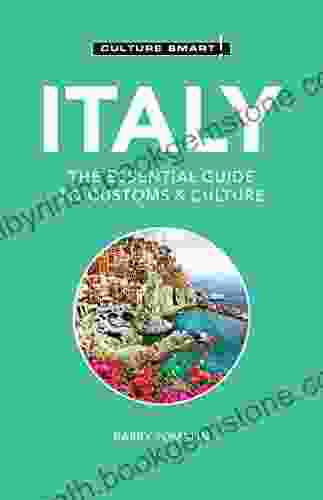
 Dwayne MitchellThe Essential Guide To Customs Culture: Traditions, Etiquette, and History
Dwayne MitchellThe Essential Guide To Customs Culture: Traditions, Etiquette, and History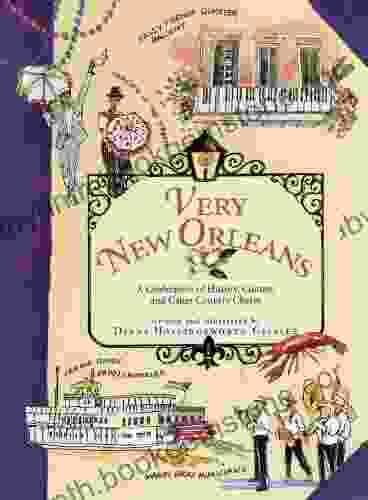
 Mike HayesA Celebration of History, Culture, and Cajun Country Charm: Delving into the...
Mike HayesA Celebration of History, Culture, and Cajun Country Charm: Delving into the... Gabriel MistralFollow ·4.2k
Gabriel MistralFollow ·4.2k Cruz SimmonsFollow ·16.6k
Cruz SimmonsFollow ·16.6k Jonathan HayesFollow ·8.4k
Jonathan HayesFollow ·8.4k Colton CarterFollow ·13.4k
Colton CarterFollow ·13.4k Jay SimmonsFollow ·2k
Jay SimmonsFollow ·2k Jaylen MitchellFollow ·19.1k
Jaylen MitchellFollow ·19.1k Edgar HayesFollow ·3.9k
Edgar HayesFollow ·3.9k Isaias BlairFollow ·10.3k
Isaias BlairFollow ·10.3k
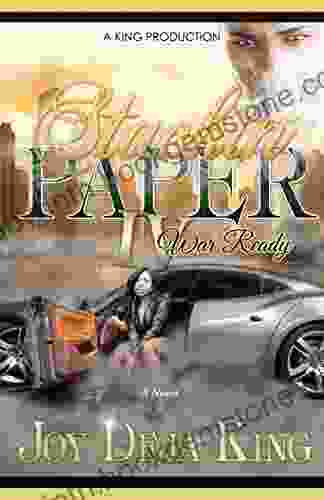
 Billy Peterson
Billy PetersonStackin' Paper Part War Ready: A Comprehensive Guide to...
In today's competitive financial landscape,...

 Jedidiah Hayes
Jedidiah HayesDennis Valder: Unveiling the Enchanting World of Cuba's...
In the heart...

 Ryan Foster
Ryan FosterDelving into the Captivating Enigma of The Green Season...
In the verdant tapestry of literary...
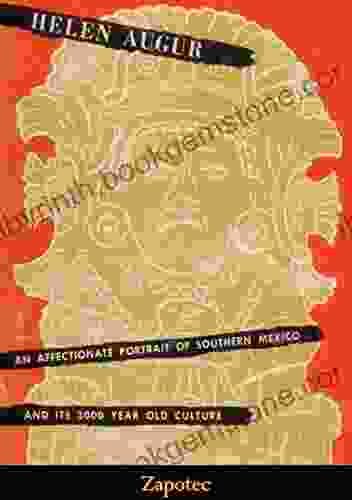
 Jeremy Mitchell
Jeremy MitchellZapotec Helen Augur: A Visionary Leader and Cultural...
In the heart of...

 Larry Reed
Larry ReedSci-Fi Alien Warrior Romance: A Tribute to the Brides of...
In the vast expanse of the...
4.7 out of 5
| Language | : | English |
| File size | : | 135300 KB |
| Print length | : | 96 pages |


